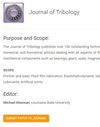A model of hydrodynamic bearings with circumferential parallel arranged grooves
IF 3
3区 工程技术
Q2 ENGINEERING, MECHANICAL
引用次数: 0
Abstract
A model is proposed to describe and analyze hydrodynamic bearings with circumferential parallel arranged grooves along any arbitrary groove curve. The Reynolds equation is solved with finite volume method, and the additional terms of the discretized equation for any arbitrary groove curve are deducted. With the model, any groove curve could be characterized by setting an array of inclination angles, and dash-shape grooves can also be modelled by setting the matrix of flag variables reflecting whether it is in the groove. Based on the model, the transient behaviors of four groove types are analyzed by Runge-Kutta method, with the pressure distribution, rotor's center orbit and leakage flow obtained. An experiment is conducted to validate the model. Results show that the dash-shape grooves, which are asymmetrical herringboned and intermittent, have both advantages of stability and sealing. The experimental and numerical results of pressure and leakage flow show good agreement in general. The model proposed in this paper will facilitate the design of grooved hydrodynamic bearings, as different groove types can be analyzed and compared by the same model.具有周向平行布置槽的流体动力轴承模型
提出了一个模型来描述和分析沿任意槽曲线具有周向平行排列槽的流体动力轴承。用有限体积法求解雷诺方程,并推导出任意槽曲线的离散方程的附加项。使用该模型,任何凹槽曲线都可以通过设置倾斜角度阵列来表征,破折号形状的凹槽也可以通过设置反映其是否在凹槽中的标志变量矩阵来建模。基于该模型,采用龙格-库塔法对四种槽型的瞬态特性进行了分析,得到了压力分布、转子中心轨道和泄漏流量。通过实验验证了该模型的正确性。研究结果表明,断续非对称圆弧形槽具有良好的稳定性和密封性。压力和泄漏流的实验和数值结果基本一致。本文提出的模型将有助于槽式流体动力轴承的设计,因为同一模型可以分析和比较不同的槽型。
本文章由计算机程序翻译,如有差异,请以英文原文为准。
求助全文
约1分钟内获得全文
求助全文
来源期刊
CiteScore
4.20
自引率
12.00%
发文量
117
审稿时长
4.1 months
期刊介绍:
The Journal of Tribology publishes over 100 outstanding technical articles of permanent interest to the tribology community annually and attracts articles by tribologists from around the world. The journal features a mix of experimental, numerical, and theoretical articles dealing with all aspects of the field. In addition to being of interest to engineers and other scientists doing research in the field, the Journal is also of great importance to engineers who design or use mechanical components such as bearings, gears, seals, magnetic recording heads and disks, or prosthetic joints, or who are involved with manufacturing processes.
Scope: Friction and wear; Fluid film lubrication; Elastohydrodynamic lubrication; Surface properties and characterization; Contact mechanics; Magnetic recordings; Tribological systems; Seals; Bearing design and technology; Gears; Metalworking; Lubricants; Artificial joints

 求助内容:
求助内容: 应助结果提醒方式:
应助结果提醒方式:


